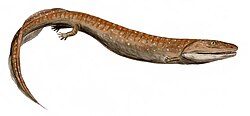| Strepsodus Temporal range: Carboniferous | |
|---|---|
 | |
| Tooth | |
| Scientific classification | |
| Domain: | Eukaryota |
| Kingdom: | Animalia |
| Phylum: | Chordata |
| Clade: | Sarcopterygii |
| Clade: | Tetrapodomorpha |
| Class: | † Rhizodontida |
| Order: | † Rhizodontiformes |
| Family: | † Rhizodontidae |
| Genus: | † Strepsodus Huxley, 1865 |
| Type species | |
| †Strepsodus sauroides Binney, 1841 | |
Strepsodus is a genus of rhizodont lobe-finned fish that lived throughout the Carboniferous period. Fossils have been found in eastern Canada, Britain (England and Scotland), and Queensland, Australia; indeterminate species of Strepsodus have also been found in the late Devonian deposits of Turkey, Iran and Colombia. [1] [2] A large individual is measured up to 3.5 metres (11.5 ft) long. [2]





